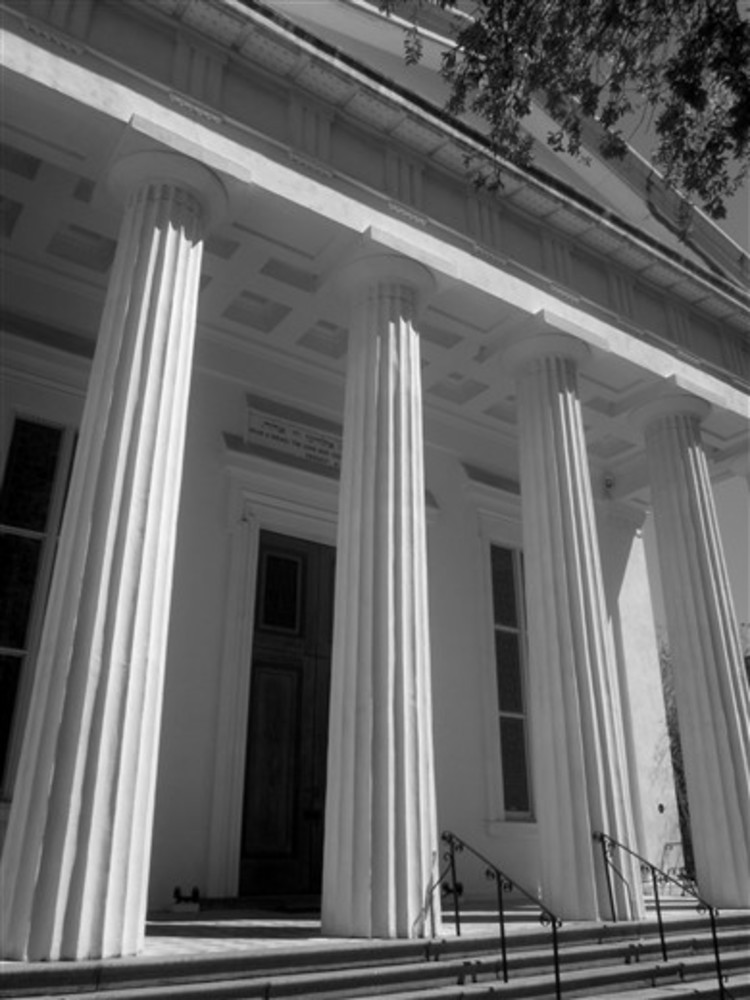Beautiful synagogues: Bold and reverent
 Beth Elohim in Charleston, South Carolina, was designed by Cyrus Warner and built in 1841. /George Goodwin
Beth Elohim in Charleston, South Carolina, was designed by Cyrus Warner and built in 1841. /George Goodwin
Architecture should do far more than buttress physical needs. At its best, it dignifies, empowers, and ennobles, becoming a spiritual force or reckoning.
Throughout the ages, however, Jews have become far more dependent upon other art forms. Literature comes first and music second, but dance and drama do not linger far behind. Eating and arguing may be additional genres! We may at times be sinful people, but we are seldom sullen or lachrymose. Our hearts sing and our spirits soar because of our divine creation.
Having been privileged to belong to three congregations with remarkable buildings, I may think too much about what makes them shimmer and glow. But during the approaching holiday season, these subtle structures remind me how much more I must do to become a better Jew.
I do not believe that older synagogues are better than newer ones, but keep in mind how age is measured. Europe’s oldest extant synagogue, Prague’s Altneuschul, was built about seven centuries ago. The oldest extant synagogue in the Americas, Curaçao’s Mikvé Israel, dates from 1701. Rhode Islanders can take everlasting pride in Newport’s Touro, North America’s oldest, completed 252 years ago.
While concerned primarily about newer American synagogues – those built within my lifetime – I do not favor urban over suburban, large over small, magnificent over spare. Although their architectural needs may differ, I do not favor one Jewish denomination over any other. My fundamental task, if possible, is to account for architectural quality – or its absence. What, like us, needs to be improved?
When compared to many other ecclesiastical structures, synagogues are in fact a quite confounding idiom. On the one hand, they symbolize faith, hope, continuity and renewal. On the other hand, Jewish life is no more sanctified within their walls than beyond. Indeed, we replenish ourselves within synagogues in order to live more righteously everywhere. In this sense, synagogues become bridges not asylums.
Remarkably, a specially designed structure is not required for Jewish prayer, study or assembly. Homes and commercial buildings have often sufficed before a young congregation can erect its own dwelling. Summer camps’ outdoor synagogues may be the best of all. An argument can be made, moreover, that a Jewish community’s most fundamental communal institution is not a building at all but low-lying land – a burial place.
Nevertheless, synagogues are extremely complicated buildings. In addition to providing large sanctuaries and small chapels (some with organ and choir lofts), they often include a labyrinth of auxiliary spaces – inside and out – such as classrooms, libraries, museums, computer labs, meeting rooms, lounges, offices, kitchens, gift shops, lavatories, storage areas, patios, playgrounds, and parking – all of which should be fully accessible, user friendly, highly secure, environmentally sensitive, technologically sophisticated, and cost effective. Indeed, while building for immediate occupancy, synagogues must simultaneously embrace the tangible and intangible, the past as well as the future. In this sense they mirror God’s presence.
Sadly, however, the life cycle of synagogues is usually quite short. Our congregations, ever searching for new promised lands, grow, splinter, merge, move, disappear and return. As we continually reinvent ourselves, we do the same with our buildings.
Despite their lofty yearnings, most American congregations have limited financial resources. This was even true of Touro, which searched widely for assistance and still does.
American synagogues may also suffer some architectural weaknesses because of congregational governance. While aspiring to be democratic, many boards of trustees are beholden to their most generous or vocal donors. When differences of opinion arise between lay leaders and clergy, boards usually prevail. But many rabbis and cantors, never having benefited from formal art or architectural studies, may also be forced to rely upon steadfast points of view.
Although Jews and gentiles have designed synagogues, few have developed a synagogue specialty. Percival Goodman, the architect of Providence’s Beth-El, built more than 60, thereby becoming the most prolific in all of Jewish history. But vast experience can also result in formulaic solutions.
Unfortunately, some boards of trustees may find it expedient to hire a congregant, especially if he or she is willing to donate or heavily discount his or her professional services. But dedication or loyalty may not be a sufficient qualification. Indeed, a prospective architect must exhibit more than a talent for verbalizing a compelling vision. He or she must have a demonstrable gift for creating an abstract language that is both bold and reverent – restless and restful.
Thus, in order to reinvigorate or redefine tradition, a conservative architect must take risks, but a daring one must not take too many. In some ideal sense – I’m not quite sure where – fusion must supersede equilibrium.
Given my concerns about architectural history and quality, I am occasionally asked if I’m an architect. No, I’m not, and I have never had such aspirations. If I have building blocks, they may be words, ideas and intuitions. Yes, I’d love to be involved with an extraordinary synagogue project. But as a perfectionist, I’d never be satisfied.
Do synagogues demand perfection? No, our creator seeks only the best in us. So I’ll lower my expectations and settle for architectural brilliance.
I am in fact grateful for many beautiful synagogues that nurture, sustain and inspire us. No pattern book exists for such magical, mysterious, and mystical creations.
If you find one, please let me know.
GEORGE M. GOODWIN, a member of Temple Beth-El in Providence has edited the Rhode Island Jewish Historical Notes for more than 10 years.







